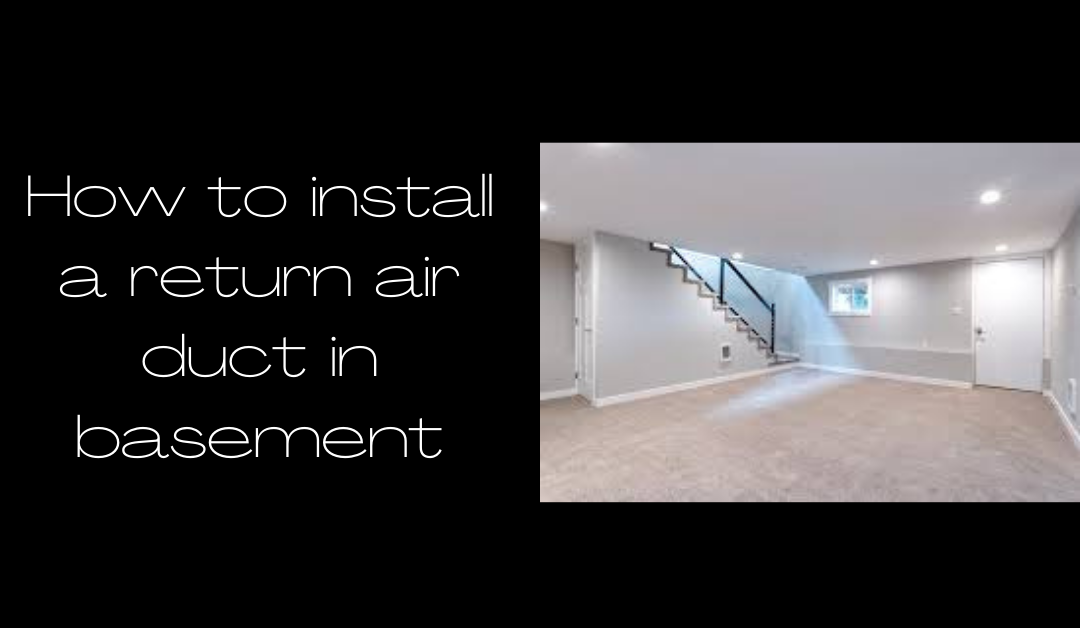The way your heating and cooling systems deliver cold and warm air to your home’s registers is via the use of ducts. Galvanized steel pipes are often used in vaults and are joined to floor registers by means of ductwork. Air is distributed throughout the home through the duct system, which also includes an inlet route and a return channel that collects and returns the collected air to the HVAC units. Installing ductwork as air duct cleaning equipment in the basement is easy if you follow the instructions in this article.
As part of your forced-air system, the supply and return ducts help circulate fresh air throughout your house, returning stale air to the furnace. A return air duct is necessary to ensure that the air in your home is correctly circulated. There are several ways in which you may utilize the ceiling joists as return air ducts. There is a real duct that goes perpendicular to the joists and then into the side of the furnace from these openings. An air duct of the type return may be easily installed if you have the correct equipment.
Installing an Air Duct (Return) in Your Basement
- The first step is to identify the problem. Determine the Location of the Ducts
Identify the ideal locations for the return air ducts in your home. In order to accommodate the return air grille, make a low-profile hole inside the drywall using a circular saw. Remember to avoid cutting any pipes or electrical wiring while installing the latest return registers in an existing property. Before moving on, make a tiny hole on the surface of the wall and take a peek inside. Size the hole to match the grille’s dimensions. Cut the floor through the hole in the wall. This should allow you to access the joist area in the basement ceiling. Once you have the amount of return air holes you want, repeat the process.
- Adding Panning is the next step
Locate the holes in the basement. Next, start installing the return air piping from the furthest hole back toward the furnace. The pans should be nailed to the joists at the bottom of the ceiling. Close the gap by bending and attaching the wire to the floor at the furthest hole. The panning of the joists should be halted at the furnace. Take it towards the floor and notch this side as well. Make joist-perpendicular trenches in the panning. As a result, this is how air from the panning will be sent to the furnace’s return duct.
- Wrap New Ducts with Insulation
Perpendicular to the joists, install the square return air duct. Start running it such that it fills in the gaps left by the cutting of the panning. Match the ditches in the pans with holes in the return air duct. The return air duct may now be reached. The S-slips and cleats for drive are used to attach the return air duct to the joists on the ceiling and provide a tight seal with the covering. Using 1 and a 1/2-inch metal facing duct wrap, insulate your return air ducts for increased energy efficiency. Your return air duct will neither acquire nor lose heat as a result of this. Use 1-inch hanger which has galvanized straps to fasten the duct to the joists in the ceiling.
- Install New Return Air Duct
In the bottom of the return duct, near the furnace, cut a small hole in the wall. Another duct will be attached here, which will go to the furnace. To fit your filter rack into the furnace, cut a hole on its side. To connect the bottom of your return cut to your filter rack and the furnace, you must first make the necessary connections. Cut the duct to size if required.
- Install a new air filter
Your filter rack is where you’ll put your filter for HVAC. An inexpensive paintbrush and duct sealant are all that are needed to provide the highest possible energy efficiency. To begin wiring up the power supply unit, attach some sheet metal pipes to the circuit breakers. The non-threaded end of the sheet metal pipe is placed over the draped end and screwed into place. To guarantee a snug fit, apply adhesive tape to the inside of each secured connection.
Use galvanized suspension strips to hold the pipes in place if they can be run between the floor beams. Hammer the galvanized slings into the beams on both sides at 4-meter intervals. If required, use galvanized suspension strips to attach the ducts to the ceiling beams by guiding them beneath the beams.
Each vent or register in your house should have an air duct that is broad enough for it to fit into it, and you should do this. In order to get a perfect fit, use sheet metal elbows and tin shears to cut pipes. Connect the pipe to the vents or registers using a metal clamp. For ventilation or registration, fold the metal clips on the collar.
Starting with the central unit, run return ductwork in a clockwise direction outwards. Turn the thermostat up to see whether the ducting is working properly. Listen for a high-pitched sound that indicates airflow. Remove any leaks by covering them with duct tape.
- Install the return air register covers in the last step
Cover the holes you drilled in the ceiling with all of your return air registers. Once the return air ducts are installed, you’re done!
Final Thoughts
It is critical that ductwork be designed and installed correctly. In order to avoid enormous charges, this task must be completed correctly the first time. But if your ducts aren’t working properly, you can have to deal with increased energy costs, uneven heating and cooling, and poor indoor air quality. The effectiveness and efficiency of pipe systems are directly related to the quality of the piping and the design of the piping.

